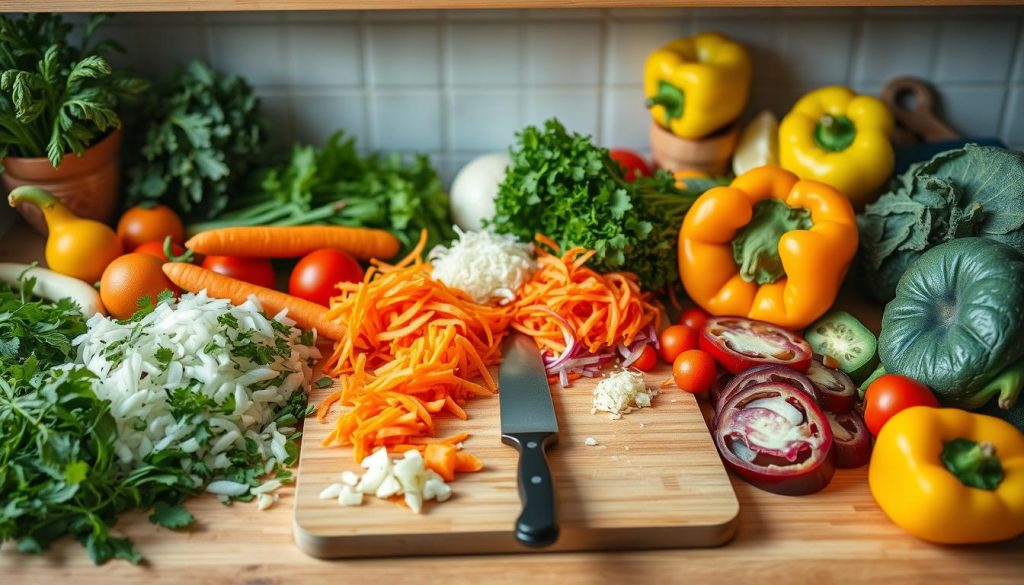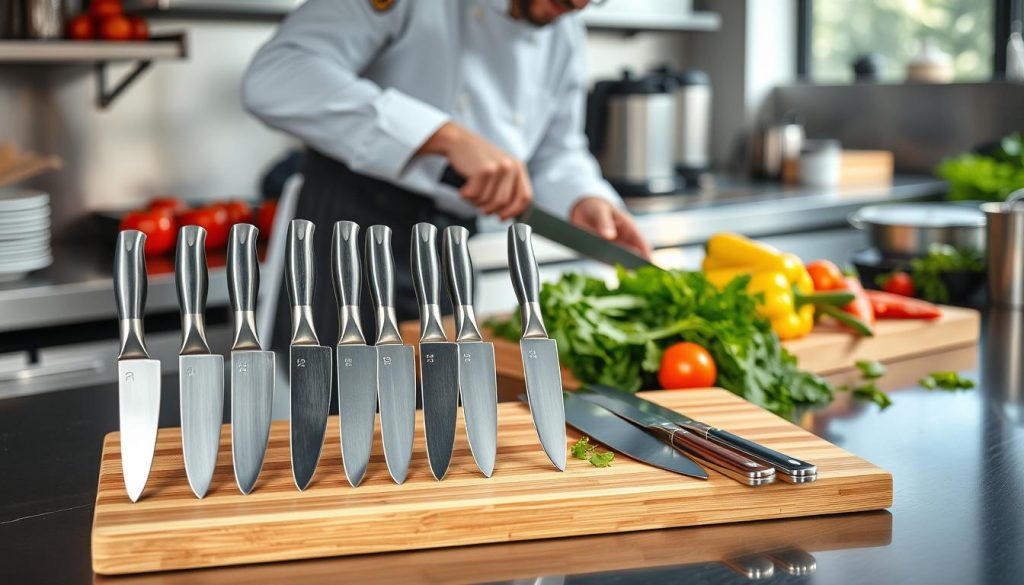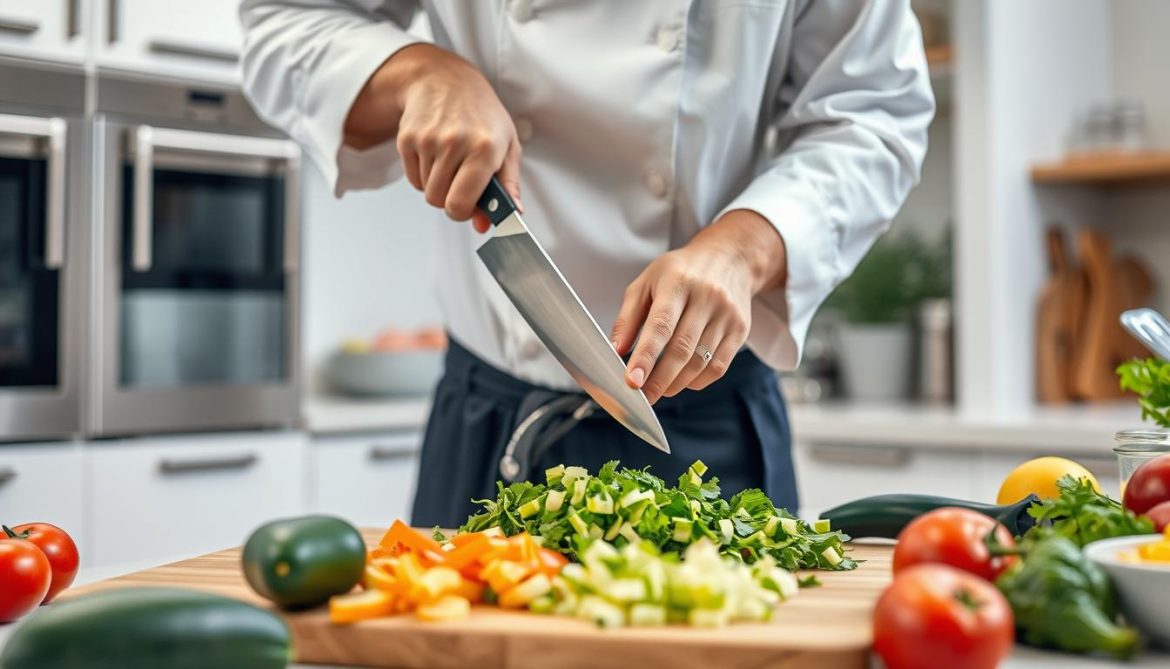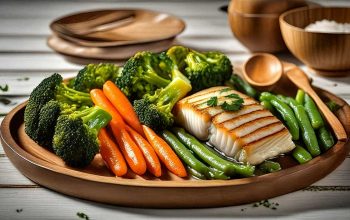Learning to cut in the kitchen is key for both home cooks and chefs. It’s about dicing veggies, slicing meat, or cutting herbs. The right knife skills can make your food prep faster, look better, and safer. This guide will teach you the basics of cutting, helping you improve your cooking.
Cutting techniques are the base of many kitchen tasks. They make your work flow better and your dishes look great. By learning the right grip, knife position, and cutting style, you’ll make cuts that impress everyone.
In this first part, we’ll cover the basics of cutting techniques. This will prepare you for more complex skills later. Get ready to sharpen your knives and improve your cooking skills.
Key Takeaways
- Cutting techniques are essential for efficient food preparation and visually appealing dish presentation.
- Proper knife handling and safety practices are crucial for a smooth and safe cooking experience.
- Understanding the right tools, grip, and cutting motions can significantly improve your cutting skills.
- Mastering the fundamentals of cutting techniques lays the groundwork for more advanced culinary skills.
- Consistent practice and attention to detail are key to becoming a proficient cutter in the kitchen.
Essential Tools for Mastering Cutting Techniques
Becoming a skilled cook is more than just having a sharp knife. You also need the right tools to support your cutting skills. From choosing the perfect cutting board to keeping your knives sharp, these tools will boost your kitchen skills.
Choosing the Right Cutting Board
The cutting board is key to your cutting skills. Look for boards made of durable materials like wood or plastic. They won’t dull your knives. Think about the size and thickness for your needs.
A bigger board gives you more space, while a thicker one is stable for heavy chopping.
Understanding Knife Grips
How you hold a knife is important for control, precision, and safety. The pinch grip is a classic and versatile choice. Other grips, like the handle grip, are good for specific tasks.
Try different grips to find what works best for you. This will help you control the knife well.
Maintenance Tools and Accessories
- Knife sharpeners: Keep your blades sharp with a quality sharpener or honing steel. Regular sharpening keeps the edge sharp for clean cuts.
- Knife storage: Store knives properly to protect them. Use a knife block or magnetic strip. This prevents damage and makes them easy to find.
- Honing steel: Use a honing steel to keep the blade sharp between full sharpenings. It realigns the edge.
With the right tools and techniques, you’ll master cutting skills. Practice, patience, and safety are key to success.
Understanding Your Kitchen Knife Collection
Having the right knives in your kitchen is key for easy and precise cooking. Each knife, from the chef’s knife to the paring knife, has its own role. This lets you express your culinary creativity.
The utility knife is great for cutting fruits, veggies, and small meats. The santoku knife is loved by chefs for its shape. It’s perfect for dicing, mincing, and chopping. For tough tasks, the cleaver is the best choice. It can cut through meat and bones with no problem.
- Chef’s knife: Versatile for a wide range of cutting tasks
- Paring knife: Ideal for delicate, precision work
- Utility knife: Handles slicing, dicing, and small meat cuts
- Santoku: Excels at dicing, mincing, and fine chopping
- Cleaver: Designed for heavy-duty tasks like cutting through bones
Creating a complete kitchen knife set takes time. But it’s a great investment. With the right knives, you’ll feel confident and efficient in the kitchen.
“The right knife in the right hand is a thing of beauty and a joy forever.”
Proper Knife Handling and Safety Practices
Proper knife handling is key to kitchen safety. It ensures your dishes are made with precision and keeps you safe from injuries. We’ll cover basic safety rules, emergency responses, and how to set up your workspace to avoid accidents.
Basic Safety Rules
- Always keep your knives sharp. Dull blades are more likely to slip and cause accidents.
- Cut away from your body, never towards it. This simple technique can prevent deep cuts and lacerations.
- Maintain a firm grip on the handle and use a stable, secure cutting board.
- Keep your fingers curled inward, with the tips tucked under, to protect them from the blade.
- Never try to catch a falling knife. Step back and let it fall to the ground.
Emergency Response Protocol
Accidents can still happen, even with the best precautions. If you get injured by a knife, apply pressure to stop bleeding first. If the cut is deep or bleeding doesn’t stop, get medical help right away. Keep a first aid kit in your kitchen for minor injuries.
Workspace Organization
An organized kitchen helps prevent knife accidents. Make sure your cutting boards, knives, and tools are easy to reach but won’t get knocked over. Keep your work surface clean and free from distractions. This setup lets you focus on cooking safely and efficiently.
Remember, kitchen safety is more than avoiding knife accidents. It’s about creating a space where you can work well and confidently. This reduces the need for first aid and makes your kitchen a positive, ergonomic workspace for cooking.
Basic Cutting Positions and Posture
Getting the perfect cut is more than just knowing the right knife moves. It’s also about how you stand and hold yourself. The right stance and posture help you cut better, feel less tired, and work more efficiently in the kitchen.
Stance and Foot Placement
Begin by standing with your feet shoulder-width apart. Place one foot slightly in front of the other. This stance helps you stay balanced and control your cuts better.
Shoulder and Arm Alignment
Keep your shoulders relaxed and your arms close to your body. Don’t hunch or tense up, as it can make you tired and less precise. Make sure your cutting arm is straight, for smooth cuts.
Head and Neck Positioning
Keep your head and neck in a neutral position. Look straight at what you’re doing. Avoid tilting or turning your head too much, to stay comfortable and precise.
By using these basic cutting positions and keeping good chef posture, you’ll cut better and protect your body. This is key for ergonomic cutting and knife control in the kitchen.
“Proper body positioning is the foundation for effortless and sustainable cutting techniques in the kitchen.”
Fundamental Knife Grip Techniques
Learning to control knives and cut with precision is key for chefs. Knowing different knife grip techniques is essential. From the pinch grip to specialized grips, let’s look at the basics of knife handling.
The Pinch Grip Method
The pinch grip is versatile and widely used. It gives you control and stability. Holding the blade between thumb and forefinger, you get a grip that lets you make precise cuts.
This grip is great for delicate slicing or dicing. It ensures your cuts are smooth and consistent.
Handle Grip Variations
While many chefs prefer the pinch grip, there are other grips too. The full handle grip is powerful and good for chopping dense ingredients. It gives you more leverage.
The extended grip is better for detailed work. It lets you move your knife more easily and control it better.
Specialty Grips for Specific Tasks
Chefs use special grips for unique tasks. The reverse grip is good for small or delicate items. It gives you more dexterity and precision.
The saber grip is useful for slicing tough ingredients. It adds stability and control.
Learning these grip techniques is vital for knife control, precision cutting, and chef techniques. By practicing these grips, you’ll become a skilled and confident chef.
Common Cutting Motion Patterns
In the world of cooking, knowing how to cut food well is crucial. There are three main ways to cut: slicing, chopping, and the rocking motion. Each method is used for different foods and results.
The slicing motion means moving the knife in straight lines. It’s great for cutting veggies, fruits, and meats into even pieces. This makes sure everything looks the same and is the right size.
The chopping motion is about hitting the knife down hard. It’s perfect for chopping herbs, onions, or hard foods quickly. It’s fast and gets the job done.
The rocking motion mixes slicing with a gentle rocking of the knife. It’s good for cutting many foods fast, like greens or soft fruits. This way, you don’t crush or tear the food.
- Slicing: Linear, back-and-forth motion for thin, even cuts
- Chopping: Firm, downward strike to quickly reduce ingredients
- Rocking motion: Combines linear slicing with a subtle rocking action for a smooth, controlled push cut
Learning these basic cutting patterns opens up many cooking possibilities. Knowing how to use each technique lets you work with all kinds of ingredients. This makes you more confident and skilled in the kitchen.
Mastering the Slice and Dice
Making uniform cuts and precise slices is key in cooking. Whether it’s for sashimi, julienned veggies, or diced onions, sharp knife skills are crucial. This section will teach you how to slice and dice like a pro.
Precision Slicing Methods
Slicing is the base of many cutting techniques. Start by sharpening your knife skills and making sure your cutting board is stable. Use a smooth, even motion and keep your fingers curled to avoid cuts.
To get uniform cuts, keep the thickness and angle the same. Slice in one motion for clean, even pieces. Practice with carrots, potatoes, and onions to improve your precision.
Dicing Techniques for Various Sizes
Dicing turns ingredients into small, uniform cubes, enhancing food presentation. Begin by slicing the ingredient thinly, then stack and slice crosswise for the desired size.
- For larger dices, aim for 1/2-inch to 1-inch cubes, perfect for hearty stews and roasted vegetables.
- Medium dices, around 1/4-inch to 1/2-inch, are ideal for sauces, salads, and quick-cooking dishes.
- Fine dices, measuring 1/8-inch to 1/4-inch, lend a delicate texture to dishes and can be used to garnish soups or sauces.
Consistent dicing makes your dishes look better and cook evenly. It ensures a great texture in every bite.
Julienne and Brunoise Techniques
In French cooking, making fine cuts is key. The julienne and brunoise cuts are crucial for beautiful and tasty dishes. Learning these techniques makes your meals look great and shows you care about how you prepare vegetables.
The Julienne Cut
The julienne cut, or matchstick, slices veggies into long, thin strips. It’s great for showing off carrots, celery, and zucchini. Here’s how to do it right:
- Trim and peel the vegetable, if necessary.
- Slice the vegetable lengthwise into thin, even slices.
- Stack the slices and cut them into long, thin strips, about 1/8 inch thick.
- Carefully separate the strips to create the julienne cut.
The Brunoise Cut
The brunoise cut is like a julienne but smaller, making tiny dice. It’s perfect for garnishes or adding to sauces and soups. Here’s how to do it:
- Start with a julienne cut.
- Slice the julienne strips crosswise into tiny, even cubes, approximately 1/8 inch in size.
- Ensure the cubes are consistent in shape and size for a professional presentation.
Getting good at these fine cuts will make your dishes look amazing. It also lets you dive into French culinary techniques and vegetable preparation. With practice, you’ll make dishes that wow everyone.
Chopping Methods for Different Ingredients
Chopping ingredients right can change how your dish tastes and looks. Whether it’s for a salad or stew, knowing how to chop is key. It’s important for both home cooks and chefs.
Vegetable Chopping Guide
Chopping veggies should make them all the same size for even cooking. Here are tips for common veggies:
- Onions: Slice into thin, even half-moons for caramelized onions or dice into small cubes for stir-fries.
- Carrots: Cut into matchsticks or thin coins for roasted veggies, or dice into small cubes for soups and stews.
- Bell Peppers: Slice into long, thin strips for fajitas or dice into small pieces for omelets and salads.
Herb Cutting Strategies
Right cutting can make herbs smell and taste better. Try these methods for chopping herbs:
- Chiffonade: Stack the leaves, roll them tightly, and slice across the roll to create thin ribbons.
- Mincing: Finely chop the herbs using a sharp knife or a mezzaluna to release their essential oils.
- Whole Leaf: Leave delicate herbs like basil and cilantro whole to preserve their texture and visual appeal.
Meat Cutting Basics
Meat cutting aims for the right texture and consistency. Here are common techniques:
| Cut | Technique | Best Use |
|---|---|---|
| Cubes | Dice the meat into evenly sized cubes | Stews, kebabs, and stir-fries |
| Strips | Slice the meat into long, thin strips | Fajitas, stir-fries, and salads |
| Thin Slices | Cut the meat into thin, even slices | Sandwiches, carpaccio, and quick-cooking dishes |
Learning to chop ingredients well can make your cooking better. It ensures your dishes have great texture, flavor, and look.

Advanced Precision Cutting Skills
In the world of professional knife skills, culinary artistry reaches new heights. Chefs who master advanced precision cutting can turn simple ingredients into stunning garnishes. They also prepare components that make any dish stand out.
The delicate art of julienne is one such technique. It involves slicing ingredients into thin, matchstick-like strips. These strips add texture and visual appeal to any dish. The key is to keep a steady, consistent motion while making sure each piece is the same size.
Creating brunoise is another advanced skill. It involves dicing ingredients into tiny, uniform cubes. This method is often used for garnishes, as the small pieces can create intricate patterns. It’s all about control and attention to detail for a perfect brunoise.
For those aiming high, creating decorative vegetable cuts is the ultimate challenge. These intricate shapes, from delicate flower petals to whimsical animals, require a deep understanding of ingredients. They also need a steady, practiced hand. Mastering these techniques can truly elevate any dish.
Like any culinary skill, mastering advanced cutting techniques takes practice and dedication. By honing their knife skills, chefs can turn ordinary ingredients into edible art.
| Cutting Technique | Description | Applications |
|---|---|---|
| Julienne | Slicing ingredients into thin, matchstick-like strips | Garnishes, salads, stir-fries |
| Brunoise | Dicing ingredients into small, uniform cubes | Garnishes, sauces, salads |
| Decorative Cuts | Intricate shapes and designs carved from vegetables and fruits | Garnishes, plate presentations, Asian cuisine |
“The true mark of a skilled chef is not just in the flavors they create, but in the artistry they bring to the plate through their professional knife skills.”
Specialized Cuts for Asian Cuisine
Exploring Asian culinary arts, we find unique cutting techniques. These are key to making famous dishes. From Japanese sushi to Chinese stir-fries, these skills show the region’s cooking talent.
Japanese Cutting Methods
In sushi making, slicing fish and ingredients is crucial. Japanese chefs use various techniques. For example, katsuramuki peels and slices veggies into thin ribbons.
The tsumami method creates fancy garnishes from food. Another technique, itamae, slices fish smoothly. This keeps the fish’s flavors and textures perfect.
Chinese Knife Techniques
Chinese cooking in the wok is all about quick cuts. The julienne method slices veggies into thin strips. This helps them cook evenly in the wok’s heat.
The chiffonade technique shreds leafy greens into thin ribbons. It makes the dish look good and ensures flavors mix well.
| Cutting Technique | Cuisine | Purpose |
|---|---|---|
| Katsuramuki | Japanese | Peeling and thinly slicing vegetables into ribbons |
| Tsumami | Japanese | Creating intricate garnishes and decorations |
| Itamae | Japanese | Precise slicing of fish for sushi |
| Julienne | Chinese | Slicing vegetables into thin, uniform strips for stir-frying |
| Chiffonade | Chinese | Finely shredding leafy greens and herbs for stir-fries |
By learning these cutting techniques, chefs in Asian culinary arts make sushi and wok cooking into art. They create dishes that amaze and please everyone.
Professional Speed Cutting Techniques
In the fast world of cooking, speed cutting is key. Chefs and culinary students have learned to cut fast and well. This makes cooking faster and more precise, whether for a big fast food preparation challenge or daily meals.
Professional chefs cut smoothly and steadily. They don’t rush but move quickly and accurately. They use special grips and patterns to cut efficiently and switch tasks fast.
- The Pinch Grip: This grip, with thumb and forefinger on the blade, offers control and precision. It’s great for slicing and dicing.
- The Claw Grip: Curling fingers inward and using knuckles as a guide, chefs hold ingredients firmly. They chop quickly with the other hand.
- The Rock Chop: Moving the blade back and forth, chefs make uniform cuts. It’s perfect for chopping lots of veggies.
Speed doesn’t mean safety should be ignored. Chefs keep their space clean, knives sharp, and watch their surroundings. This way, they work efficiently without risking their safety.
“The secret to lightning-fast cutting isn’t just about the motion; it’s about the mindset. Staying focused, confident, and in control is key to unlocking your true cutting potential.”
Learning speed cutting can change your cooking game. It’s useful for both professional chefs and home cooks. With practice and attention to detail, you can improve your cooking speed and efficiency.

Troubleshooting Common Cutting Problems
Learning to cut in the kitchen is rewarding but comes with its own set of challenges. We’ll look at ways to solve common cutting issues. This will help you improve your knife skills and make cutting easier.
Dealing with Tough Ingredients
Some foods, like hard veggies, tough meats, or frozen items, can be tough to cut. Here are some tips to help:
- Use a sharp, high-quality knife to make cutting easier.
- Try the rock chop technique to slowly cut through tough ingredients.
- Pre-soften hard veggies by steaming or blanching before cutting.
- Let frozen foods thaw a bit to make cutting easier.
Correcting Bad Habits
Improving your cutting skills means breaking bad habits. If you notice bad habits, like wrong grip or cutting motion, fix them:
- Go back to learning proper knife handling and grip.
- Practice different cutting techniques, like slice and dice, to get it right.
- Pay attention to your posture and stance to stay balanced.
- Focus on precision, not speed, to improve your skills slowly.
By tackling common cutting problems and fixing bad habits, you’ll get better at knife skills improvement. You’ll master the cutting challenges in your kitchen.
Maintaining Your Cutting Edge
Keeping your kitchen knives sharp is key for easy cutting and great cooking. Learning knife sharpening, blade care, and kitchen maintenance boosts your cooking skills. It also makes your knives last longer.
Sharpening: The Key to a Keen Edge
Sharpening your knives regularly is essential. You can use a manual sharpener, electric device, or whetstone. It’s important to sharpen your knives often to keep them sharp and working well. Find a sharpening routine that fits your kitchen and cooking style.
Proper Storage and Cleaning
- Store your knives safely in a knife block, magnetic strip, or individual sheaths to protect the blades from damage.
- Clean your knives thoroughly after each use, removing any food residue or moisture to prevent corrosion and dullness.
- Avoid submerging your knives in water for extended periods, as this can lead to rust and deterioration.
Accessorize for Blade Longevity
Get a good honing steel or sharpening stone to keep your knives sharp between sharpening. Use a knife sharpening guide or angle guide for even sharpening. This helps keep your knives sharp and ready for any cooking task.
By learning knife sharpening, blade care, and kitchen maintenance, your knives will always be ready. They’ll help you tackle any cooking challenge with ease and precision.
Conclusion
Starting your journey to master culinary skills? Remember, cutting is key to feeling confident and efficient in the kitchen. This guide has covered the basics, from tools to techniques, to help you get better at cutting.
You now know how to use your knives well and cut ingredients with precision. You’ve also learned special cutting methods for Asian dishes and how to cut fast. These skills will make your cooking better and impress your friends.
Keep practicing and improving your cutting skills. This will keep you sharp, both in your knife work and in your cooking. With hard work and a love for learning, you’ll become more confident and efficient in the kitchen.


